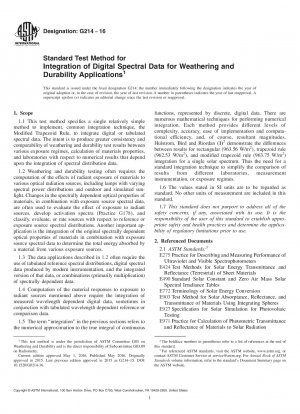ASTM G214-16
Standard Test Method for Integration of Digital Spectral Data for Weathering and Durability Applications
- Standard No.
- ASTM G214-16
- Release Date
- 2016
- Published By
- American Society for Testing and Materials (ASTM)
- Status
- Replace By
- ASTM G214-23
- Latest
- ASTM G214-23
- Scope
5.1 Weathering and durability testing often requires the computation of the effects of radiant exposure of materials to various optical radiation sources, including lamps with varying spectral power distributions and outdoor and simulated sunlight as in Test Methods E972, G130, and G207.
5.2 The purpose of this test method is to foster greater consistency and comparability of weathering and durability test results between various exposure regimes, calculation of materials properties, and laboratories with respect to numerical results that depend upon the integration of spectral distribution data.
5.3 Changes in the optical properties of materials such as spectral reflectance, transmittance, or absorptance are often the measure of material stability or usefulness in various applications. Computation of the material responses to exposure to radiant sources mentioned above requires the integration of measured wavelength-dependent digital data, sometimes in conjunction with tabulated wavelength-dependent reference or comparison data.
5.4 This test method specifies and describes the Modified Trapezoid Rule as a single reasonably accurate and easily implemented integration technique for computing approximations of spectral source and optical property integrals.
5.5 The method includes a procedure for estimating the approximate absolute and relative (percent) error in the estimated spectral integrals.
5.6 The method includes a procedure to construct data sets that match in spectral wavelength and spectral wavelength interval, which does not have to be uniform over the spectral range of interest. Uniform spectral intervals simplify some of the calculations, but are not required.
1.1 This test method specifies a single relatively simple method to implement, common integration technique, the Modified Trapezoid Rule, to integrate digital or tabulated spectral data. The intent is to produce greater consistency and comparability of weathering and durability test results between various exposure regimes, calculation of materials properties, and laboratories with respect to numerical results that depend upon the integration of spectral distribution data.
<......1.2 Weathering and durability testing often requires the computation of the effects of radiant exposure of materials to various optical radiation sources, including lamps with varying spectral power distributions and outdoor and simulated sunlight. Changes in the spectrally dependent optical properties of materials, in combination with exposure source spectral data, are often used to evaluate the effect of exposure to radiant sources, develop activation spectra (Practice G178), and classify, evaluate, or rate sources with respect to reference or exposure source spectral distributions. Another important application is the integration of the original spectrally dependent optical properties of materials in combination with exposure source spectral data to determine the total energy absorbed by a material from various exposure sources.
ASTM G214-16 Referenced Document
- ASTM E275 Standard Practice for Describing and Measuring Performance of Ultraviolet, Visible, and Near-Infrared Spectrophotometers
- ASTM E424 Standard Test Methods for Solar Energy Transmittance and Reflectance (Terrestrial) of Sheet Materials
- ASTM E490 Standard Solar Constant and Zero Air Mass Solar Spectral Irradiance Tables
- ASTM E772 Standard Terminology Relating to Solar Energy Conversion
- ASTM E903 Standard Test Method for Solar Absorptance, Reflectance, and Transmittance of Materials Using Integrating Spheres
- ASTM E927 Standard Specification for Solar Simulation for Terrestrial Photovoltaic Testing
- ASTM E971 Standard Practice for Calculation of Photometric Transmittance and Reflectance of Materials to Solar Radiation
- ASTM E972 Standard Test Method for Solar Photometric Transmittance of Sheet Materials Using Sunlight
- ASTM E973 Test Method for Determination of the Spectral Mismatch Parameter Between a Photovoltaic Device and a Photovoltaic Reference Cell
- ASTM G113 Standard Terminology Relating to Natural and Artificial Weathering Tests of Nonmetallic Materials
- ASTM G130 Standard Test Method for Calibration of Narrow- and Broad-Band Ultraviolet Radiometers Using a Spectroradiometer
- ASTM G138 Standard Test Method for Calibration of a Spectroradiometer Using a Standard Source of Irradiance
- ASTM G151 Standard Practice for Exposing Nonmetallic Materials in Accelerated Test Devices that Use Laboratory Light Sources
- ASTM G173 Standard Tables for Reference Solar Spectral Irradiances: Direct Normal and Hemispherical on 37° Tilted Surface
- ASTM G177 Standard Tables for Reference Solar Ultraviolet Spectral Distributions: Hemispherical on 37 Tilted Surface
- ASTM G178 Standard Practice for Determining the Activation Spectrum of a Material (Wavelength Sensitivity to an Exposure Source) Using the Sharp Cut-On Filter or Spectrographic Technique
- ASTM G197 Standard Table for Reference Solar Spectral Distributions: Direct and Diffuse on 20° Tilted and Vertical Surfaces
- ASTM G207 Standard Test Method for Indoor Transfer of Calibration from Reference to Field Pyranometers
ASTM G214-16 history
- 2023 ASTM G214-23 Standard Test Method for Integration of Digital Spectral Data for Weathering and Durability Applications
- 2016 ASTM G214-16 Standard Test Method for Integration of Digital Spectral Data for Weathering and Durability Applications
- 2015 ASTM G214-15 Standard Test Method for Integration of Digital Spectral Data for Weathering and Durability Applications
